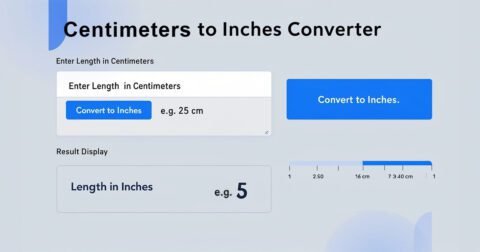Fluid Ounces to Milliliters Calculator
Convert between ounces and milliliters with precision and visual guides
Visual Comparison
Conversion History
Recipe Scaling Calculator
Scale your recipe up or down while maintaining perfect proportions
Recipe Measurement Conversions
Common Fluid Ounce to Milliliter Conversions
Kitchen Measurement Equivalents
Container Size Reference
1.5 oz
5 oz
8 oz
12 oz
16 oz
“Dash of Ounce, Splash of Milliliter—Help!”
Saturday, 6 p.m. You’re midway through a TikTok cocktail tutorial and—boom—the mixologist drops “2 oz of mezcal.” Your measuring jug is metric. Panic? Nah. Fire up an oz to mL calculator (or build one in 90 seconds), and keep the party shaking.
In this bite-but-mighty article you’ll:
Decode the exact ounce-to-milliliter ratios (yes, US ≠ Imperial)
Run through hands-on examples with bartending and baby-formula use-cases
Build micro-calculators in Google Sheets, Excel, and Python
Spot sneaky pitfalls (rounded ounces, temperature corrections, mislabeled jiggers)
Pocket a printable cheat chart for kitchen, bar, or lab
Grab your jigger—let’s pour some knowledge.
Table of Contents (Hop to What You Need)
Break-the-Template Alert: Expect anecdotes, a cheeky emoji, and one inevitable dad joke about “fluid intelligence.” You were warned.
1. Ounce vs. Milliliter—Quick Primer
Fluid Ounce (fl oz): A volume unit rooted in old wine trade—different sizes in the US and the UK.
Milliliter (mL): Metric volume unit; 1 mL = 1 cubic centimeter. Global standard for science, medicine, and most of the culinary world.
Why You Care: Recipes, lab protocols, and baby-bottle instructions often hop between the two. A sloppy 5 % conversion error can wreck espresso flavor or titration accuracy.
2. Exact Conversion Factors
| System | 1 fl oz = ? mL | Notes |
|---|---|---|
| US customary | 29.573 529 56 mL | Used in American food regulation, bartending, nutrition labels. |
| Imperial (UK, pre-metric) | 28.413 062 5 mL | Still lurks in vintage barware and older cookbooks. |
Fast Mental Math
Rough-and-Ready: Multiply US oz × 30 = ballpark mL (within 1.4 %).
Home Bartender’s Shortcut: 1 oz ≈ 30 mL, ½ oz ≈ 15 mL, ¼ oz ≈ 7.5 mL.
But for espresso puck science or pharmaceutical dilution, use the precise factor—your crema and patient will thank you.
3. Hands-On Walk-Through
3.1 Margarita, Metric-Style
The classic spec:
2 oz tequila, 1 oz Cointreau, 1 oz fresh lime juice.
Step 1: Identify ounce type—most bar recipes = US.
Step 2: Plug into calculator or multiply by 29.5735.
| Ingredient | US oz | ×29.5735 = mL |
|---|---|---|
| Tequila | 2 | 59.15 |
| Cointreau | 1 | 29.57 |
| Lime | 1 | 29.57 |
Shake, strain—cheers. 🇲🇽
3.2 Baby-Formula Bottle
Label says: “Add 4 fl oz water.” You’re in London with a metric bottle.
If package is US-marketed → 4 × 29.5735 = 118.29 mL. Round to 118 mL for bottle marking.
4. DIY Calculators
4.1 Google Sheets / Excel
= A2 * 29.57352956 // US fluid ounces in column A
Add a dropdown cell to switch factor to 28.413 for Imperial.
4.2 Python One-Liner
us_oz = 2.5
ml = us_oz * 29.57352956
print(f"{us_oz} US fl oz = {ml:.2f} mL")
Wrap in a Streamlit app and you’ve got a mobile-friendly converter for your bar staff.
4.3 No-Code Web Widget
Tools like Convertful or Typeform let you embed a two-field oz↔mL converter on your recipe blog—copy-paste factor, style, done.
5. Printable Cheat-Sheet (Top 15 Values)
| US oz | mL (exact) | US oz | mL | |
|---|---|---|---|---|
| ¼ | 7.39 | 5 | 147.87 | |
| ½ | 14.79 | 6 | 177.44 | |
| ¾ | 22.18 | 8 | 236.59 | |
| 1 | 29.57 | 12 | 354.88 | |
| 2 | 59.15 | 16 | 473.18 |
Print, laminate, stick on fridge. Kitchen arguments—silenced.
6. Common Pitfalls & How to Dodge Them
| Pitfall | Why It Hurts | Fix |
|---|---|---|
| Mixing US & Imperial | 3.9 % error sneaks in. | Check recipe origin; mark bar tools. |
| Weight vs. Volume Confusion | 1 oz weight ≠ 1 fl oz volume (think honey). | Look for “fl oz” explicitly. |
| Rounded Jiggers | Some jiggers labeled “1 oz” hold 1 ¼. | Test with scale or graduate cylinder. |
| Temperature-Ignoring Lab Work | mL vary ≤0.3 %/°C for some solvents. | Conduct volumetrics at calibration temp. |
| Blind Copy-Paste of Online Tables | SEO farms often mis-state factor. | Cross-verify with NIST or UK Weights & Measures docs. |
7. Industry Use-Cases
Specialty Coffee: Dial-in espresso yields—30 mL shot ≈ 1 US fl oz.
Cosmetics R&D: Convert fragrance oils from supplier sheets (oz) to lab beakers (mL).
Homebrewing: Convert hop extracts labeled in ounces to metric kettles.
Clinical Dosing: Nurses translate prescription oz → syringe mL for US expatriates abroad.
Aviation Catering: Airlines preload beverage carts using global metric specs; US-based recipes need oz→mL tables.
8. Mini FAQ
Q1: Can I use 30 mL per oz for nutrition labels?
Legally, US FDA requires the exact 29.5735 mL factor.
Q2: Do shot glasses equal 1 oz everywhere?
No—Japan’s standard shot is 30 mL; Australia, 30 or 15 mL; UK, 25 mL. Verify.
Q3: Is there a dual-unit jigger?
Yes—OXO and Cocktail Kingdom sell ones etched with mL on one side, oz on the other.
Q4: What about fluid-drachms or gills?
Fun trivia, but ignore unless you’re digitizing 19th-century pharmacy texts.
Q5: Are mL and cc interchangeable?
Clinically, yes. 1 mL = 1 cc.
9. Wrap-Up Challenge
Scan your kitchen or bar—count how many tools list only ounces.
Stick the printable cheat-sheet nearby.
Convert your three favorite recipes to pure metric and share on social with #MetricCocktail.
Tag me @howtopredict—best post wins a digital bar cheat-card.


